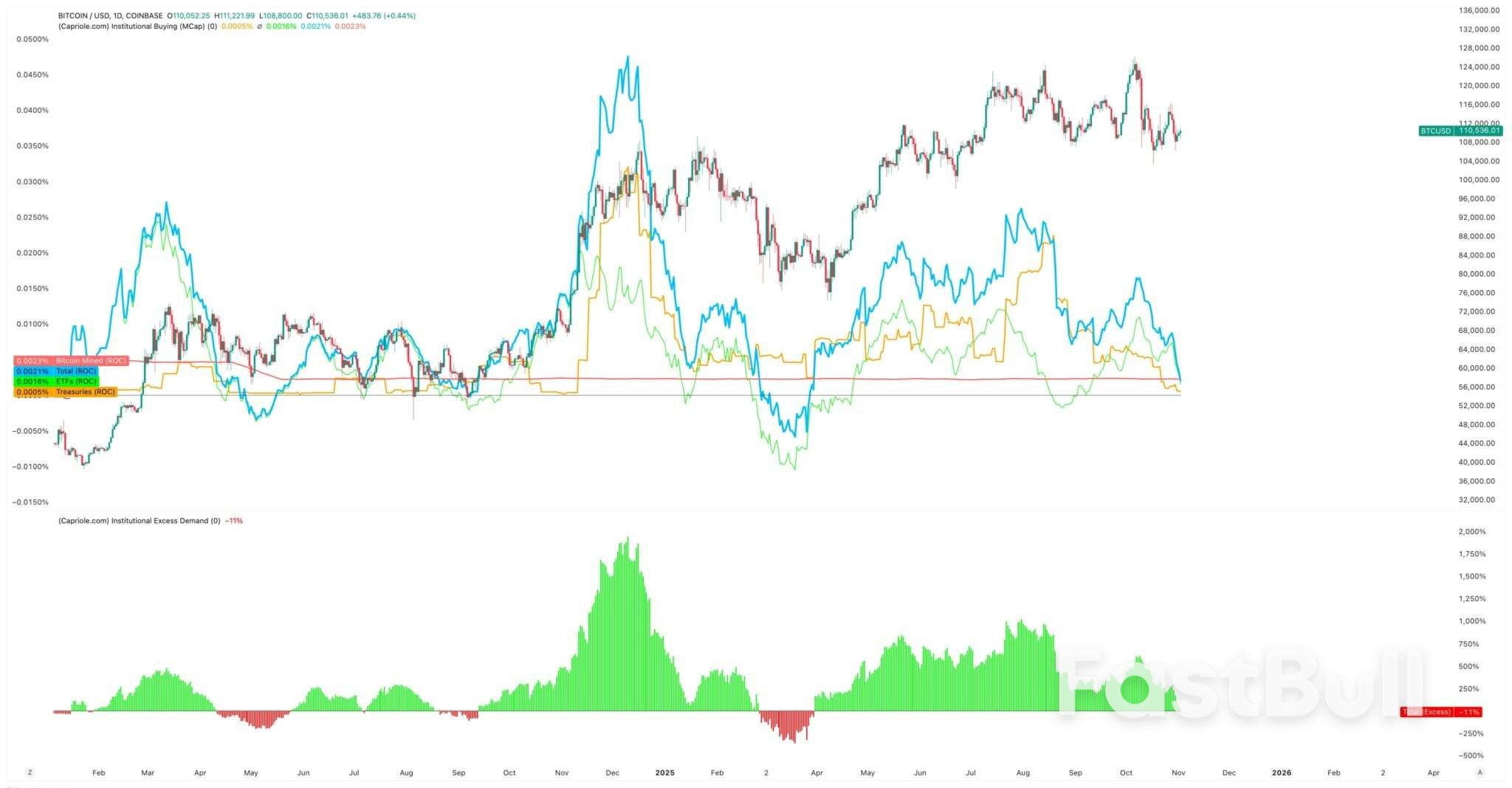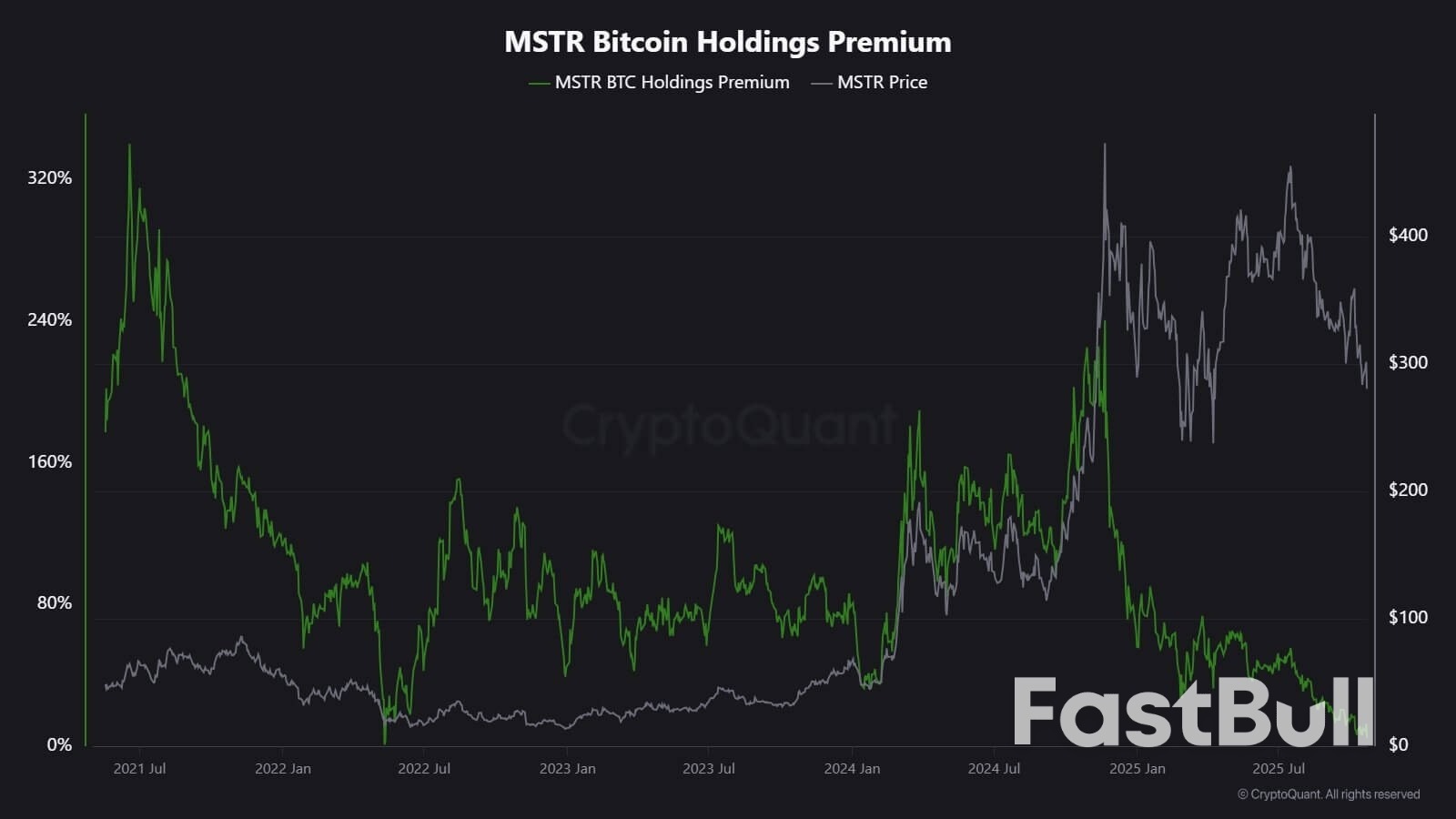For most of 2025, Bitcoin’s floor looked unshakable, supported by an unlikely alliance of corporate treasuries and exchange-traded funds.
Companies issued stock and convertible debt to buy the token, while ETF inflows quietly soaked up new supply. Together, they created a durable demand base that helped Bitcoin defy tightening financial conditions.
Now, that foundation is beginning to shift.
In a Nov. 3 post on X, Charles Edwards, founder of Capriole Investments, stated that his bullish outlook has weakened as the pace of institutional accumulation has waned.
He noted: “For the first time in 7 months, net institutional buying has DROPPED below daily mined supply. Not Good.”

According to Edwards, this was the key metric that had kept him optimistic, even as other assets outperformed Bitcoin.
However, with the current situation, he noted that there are now roughly 188 corporate treasuries that hold sizable Bitcoin positions, many with limited business models beyond their token exposure.
Bitcoin treasury purchases slowdown
No company defines the corporate Bitcoin trade more than MicroStrategy Inc., which recently shortened its name to Strategy.
The Michael Saylor-led software maker, which has transformed into a Bitcoin treasury company, now holds more than 674,000 BTC, solidifying its position as the largest single corporate holder.
Its buying rhythm, however, has slowed sharply in recent months.
For context, Strategy added about 43,000 BTC in the third quarter, which is its lowest quarterly purchase this year. This number is unsurprising considering the firm saw some of its Bitcoin purchases drop to only a few hundred coins during the period.
CryptoQuant analyst J.A. Maarturn explained that the slowdown could be linked to the Strategy’s falling NAV.
According to him, investors once paid a hefty “NAV premium” for every dollar of Bitcoin on Strategy’s balance sheet, effectively rewarding shareholders with leveraged exposure to BTC’s upside. That premium has compressed since mid-year.
With fewer valuation tailwinds, issuing new shares to buy Bitcoin is no longer as accretive, dulling the incentive to raise capital.
Maarturn noted: “Capital is harder to raise. Equity issuance premiums have dropped from 208% [to] 4%.”

Meanwhile, the cooling extends beyond MicroStrategy.
Metaplanet, a Tokyo-listed firm that modeled itself on the US pioneer, recently traded below the market value of its own Bitcoin holdings after a steep drawdown.
In response, it authorized a share buyback while introducing new guidelines for raising capital to grow its Bitcoin treasury. The move signaled confidence in its balance sheet but also highlighted waning investor enthusiasm for “digital-asset treasury” business models.
In fact, the slowdown in Bitcoin treasury acquisitions has resulted in a merger between some of these firms.
Last month, asset management firm Strive announced its acquisition of Semler Scientific, a smaller BTC treasury company. This deal would allow these firms to hold nearly 11,000 BTC at a premium that is effectively becoming a scarce resource in the sector.
These examples reflect a structural constraint rather than a loss of conviction. When equity or convertible issuance no longer commands a market premium, capital inflows dry up, naturally slowing corporate accumulation.
ETF flows?
Spot Bitcoin ETFs, long viewed as automatic absorbers of new supply, are showing similar fatigue.
For much of 2025, these financial investment vehicles dominated net demand, with creations consistently exceeding redemptions, especially during Bitcoin’s surge to record highs.
But by late October, their flows have turned choppy. Some weeks saw a shift to negative territory as portfolio managers rebalanced positions and risk desks trimmed exposure in response to shifting interest-rate expectations.
That volatility marks a new phase in the behavior of Bitcoin ETFs.
The macro backdrop has tightened, and hopes for rapid rate cuts have faded; real yields have risen, and liquidity conditions have cooled.
Nonetheless, demand for Bitcoin exposure remains firm, but it now arrives in bursts instead of steady waves.
Data from SoSoValue illustrates this shift. In the first two weeks of October, the digital-asset investment products attracted nearly $6 billion in inflows.
However, by the end of the month, a portion of those gains had been reversed as redemptions increased to more than $2 billion.
The pattern suggests that Bitcoin ETFs have matured into genuine two-way markets. They still provide deep liquidity and institutional access, but they no longer behave as one-directional accumulation vehicles.
When macro signals wobble, ETF investors can exit just as quickly as they enter.
Market implications for Bitcoin
This evolving scenario doesn’t automatically spell a downturn, but it does imply greater volatility. With corporate and ETF absorption softening, Bitcoin’s price action would be increasingly driven by shorter-term traders and macro sentiment.
In such situations, Edwards argues that fresh catalysts, such as monetary easing, regulatory clarity, or the return of equity-market risk appetite, could reignite the institutional bid.
However, as the marginal buyer looks more cautious for now, this leaves price discovery more sensitive to global liquidity cycles.
As a result, the effect is twofold.
First, the structural bid that once acted as a floor is weakening.
During periods of under-absorption, intraday swings can amplify because fewer steady buyers exist to dampen volatility. The April 2024 halving mechanically reduced new supply, but without consistent demand, scarcity alone doesn’t guarantee higher prices.
Second, Bitcoin’s correlation profile is shifting. As balance-sheet accumulation cools, the asset may again track the broader liquidity cycle. Rising real yields and strong dollar phases could pressure prices, while easing conditions might restore its leadership in risk-on rallies.
In essence, Bitcoin is re-entering its macro-reflexive phase and behaving less like digital gold and more like a high-beta risk asset.
Meanwhile, none of this negates Bitcoin’s long-term narrative as a scarce, programmable asset.
Rather, it reflects the growing influence of institutional dynamics that once insulated it from retail-driven swings. The same mechanisms that lifted Bitcoin into mainstream portfolios are now binding it more tightly to the gravity of capital markets.
The coming months will test whether the asset can sustain its store-of-value appeal without automatic corporate or ETF inflows.
If history is any guide, Bitcoin tends to adapt: when one demand channel slows, another often emerges—be it from sovereign reserves, fintech integrations, or renewed retail participation during macro easing cycles.
Source: Cryptoslate











